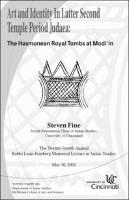Please use this identifier to cite or link to this item:
https://hdl.handle.net/20.500.12202/5820| Title: | Art and Identity in Latter Second Temple Period Judaea : The Hasmonean Royal Tombs at Modi‘in. |
| Authors: | Fine, Steven |
| Keywords: | Second Temple Period Judaea Jewish art Jewish identity Hasmonean Royal Tombs Modi'in |
| Issue Date: | 10-May-2001 |
| Publisher: | Cincinnati: University of Cincinnati, Department of Judaic Studies. |
| Citation: | Fine, Steven. (2002). Twenty-fourth Annual Rabbi Louis Feinberg Memorial Lecture in Judaic Studies. Cincinnati: University of Cincinnati, Department of Judaic Studies. |
| Series/Report no.: | Annual Rabbi Louis Feinberg Memorial Lecture in Judaic Studies;24th |
| Abstract: | The hypothetical late Second Temple period Judaean with whom we began this discussion would have been stymied if asked for his opinions regarding “art.” Even still, our Judaean would certainly have known what he found visually pleasing when he saw it. Much of the Greco-Roman visual heritage would have been known and perhaps appreciated by him. The glories of Jerusalem, the beauty of the Hasmonean tombs, and the fine craftsmanship of well-made household vessels might all have been within his experience. At the same time, our Judaean would have had definite limits regarding acceptable visual imagery. “Idolatrous” foreign iconography was forbidden, at least in principle. With the Hasmonean revolt the exclusion of idolatry became an active (and at times activist) feature of communal identity, though Hellenistic art per se was not problematic. The Hasmonean tombs, architectural structures that fully reflect the visual vocabulary of their time, are a fine example of Hasmonean participation in Hellenistic art. I would argue that the intensification of “anti-idolism” beginning with the Hasmoneans was a neoconservative attempt to restore an imagined situation that existed before the traumatizing rule of Antiochus IV Epiphanes. Over the almost two centuries between the construction of the Hasmonian tombs and Josephus Flavius’ depiction of these monuments, the attitudes of many Jews toward Greco-Roman visual culture became increasingly more strident. This stringency may simultaneously reflect both greater integration into that culture and a desire by some to restrict connections with it through the construction of social boundaries. This transformation is well reflected in Josephus’ writings and in other latter Second Temple period sources. This process is exemplified in the construction and subsequent transformation of the Hasmonean royal tombs at Modi‘in. (From Conclusion) |
| Description: | Published lecture. |
| URI: | https://hdl.handle.net/20.500.12202/5820 |
| Appears in Collections: | Bernard Revel Graduate School of Jewish Studies (BRGS): Faculty Publications |
Files in This Item:
| File | Description | Size | Format | |
|---|---|---|---|---|
| Fine 2002 The_Hasmonean_Royal_Tombs_at_Modi_in_Art (1).pdf | 615.48 kB | Adobe PDF |  View/Open |
This item is licensed under a Creative Commons License

